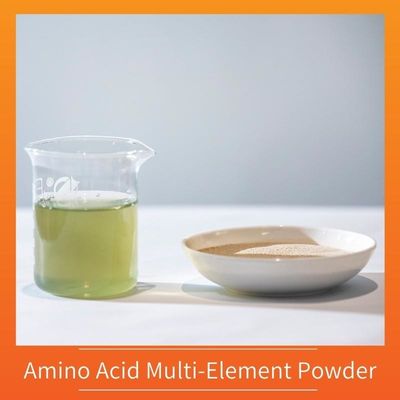Amino Acid Chelated Multi Element N6 Amino Acid Powder Fertilizer/Liquid Fertilizer 65072-01-7
Amino Acid Chelated Multi-Element Powder
| Appearance |
Yellow Powder |
| Amino Acid |
≥25% |
| TE |
≥15% |
| Fe |
5% |
| Zn |
Zn4% |
| B |
3% |
| Mn |
2% |
| Cu |
1% |
| Mo |
0.1% |
| PH |
3~5 |
| Total Nitrogen |
≥6% |
| Solubility |
100% soluble |
The trace element in the product are all chelated.
Our product is concentrated ,diluted with water and then sprayed with drio irrigation.
When the powder is diluted, the liquid is green and transparent.
Our product is suitable for plants and soils that are deficent in most elements.
The content of common elements cannot be equated with that of chelated elements.
We use conventional kraft paper bags for packing, 25kg/ bag.
We also support customer requirements, customized packaging.
Cu
The crops highly sensitive to copper deficiency are: barley, wheat, oats, rice, alfalfa, lettuce, shallots, spinach, Onions, carrots, beets, sultanate, citrus, sunflower, etc.
Crops moderately sensitive to copper deficiency include corn, sorghum, clover, cabbage, cauliflower, celery, cucumber, radish, coriander, turnips, pineapple, tomato, cotton, strawberry, apple, pear, peach, etc.
The crops sensitive to copper deficiency are soybean, broad bean, pea, rape, asparagus and so on.
Fe
Generally speaking, crops with reducing capacity in the rhizosphere and secreting some organic matter that can chelate iron (e.g., oats secrete maganic acid) can effectively utilize soil iron and less iron deficiency occurs. However, some crops are prone to iron deficiency because their rhizosphere is oxidized.
Highly sensitive to iron deficiency are peanuts, soybeans, broad beans, sorghum, cauliflower, kale, tomatoes, mint, sultanate, grapes, strawberries, citrus, apples, peaches, pears, walnuts, cherries, etc.
Moderately sensitive to iron deficiency are: oats, barley, corn, alfalfa, cotton, flax, etc.
The crops with low sensitivity to iron deficiency include rice, millet, potato, sugar beet, etc.
Zn
The crops highly sensitive to zinc are: corn, rice, soybean, broad bean, camelina, castor bean, tobacco, sunflower, hops, towelia, cabbage, lettuce, celery, spinach, peach, cherry, apple, pear, plum, apricot, citrus, grape, walnut, pomegranate, papaya, coffee, etc.
The crops moderately sensitive to zinc were sorghum, alfalfa, clover, potato, tomato, beet, sultanate, shallot, tomato, barley, etc.
The crops with low sensitivity to zinc deficiency include pea, asparagus, grass, carrot, safflower, mint, etc.
Mn
Since the role of manganese in making objects includes many aspects, there are many crops that respond to manganese fertilizer, including grain, cotton, oil, sugar, tobacco, fruit trees and vegetables.
Crops highly sensitive to manganese deficiency include peanuts, soybeans, peas, mung beans, oats, wheat, tobacco, beets, potatoes, Onions, lettuce, spinach, lemons, apples, peaches, pecans, citrus, etc.
For manganese reaction medium sensitive crops are: alfalfa, sesbania, Chinese trumpet creeper, pea, clover, forage grass, barley, maize, sorghum, flax, mint, sugar beet, cabbage, broccoli, celery, tomato, parsley, carrots, cotton, etc
Crops with low sensitivity to manganese deficiency include rye, asparagus and so on.
B
More than 50 species of crops have good response to borax fertilizer, and most dicotyledon crops require more boron than monocotyledon crops.
Perennial crops have a high boron requirement and a high boron environment tolerance. The application of borax fertilizer to cruciferous crops tends to be more effective. Root crops have the greatest demand for borax fertilizer.
Many legumes, fiber crops, fruit trees and vegetables also respond well to the application of borax. The boron requirement of gramineous crops is low, but when boron is insufficient in the soil, the application of borax fertilizer also has a good effect.
Highly sensitive to boron deficiency were: beet, alfalfa, clover, rape, lettuce, cauliflower, Chinese cabbage, cabbage, turnip, kale, celery, radish, coriander, sunflower, grape, apple, lemon, olive, etc.
Sensitive to moderate b in crops are: Chinese trumpet creeper, peanuts, carrot, tomato, spinach, onion, potato, pepper, mustard, sweet potato, tobacco, cotton, peach, pear, America hickory, cherry, olives, etc.
Mo
Since the physiological effects of molybdenum are related to the nitrogen fixation of rhizobia, leguminous crops have special requirements for molybdenum.
Crops highly sensitive to molybdenum deficiency (mu) include peanuts, clover, cabbage, cauliflower, spinach, lettuce, shallots, etc.
For molybdenum deficiency moderately sensitive crops are: alfalfa, Chinese trumpet creeper, peas, beans, broad beans, mung beans, rape, cabbage, radish, coriander, tomatoes, carrots, oranges and so on.
The crops with low sensitivity to molybdenum deficiency include barley, wheat, rice, corn, potato, cotton, grass and so on.





 Your message must be between 20-3,000 characters!
Your message must be between 20-3,000 characters! Please check your E-mail!
Please check your E-mail!  Your message must be between 20-3,000 characters!
Your message must be between 20-3,000 characters! Please check your E-mail!
Please check your E-mail! 






